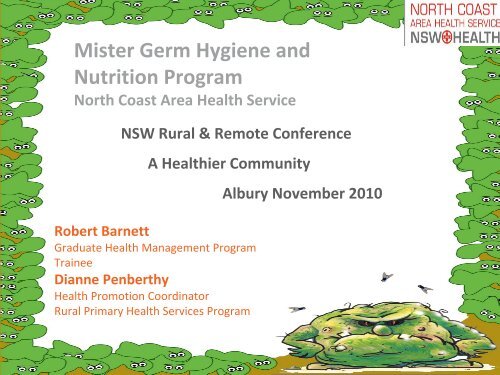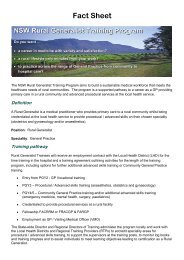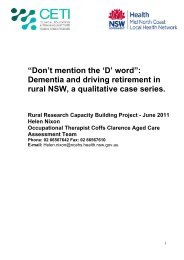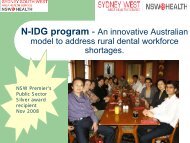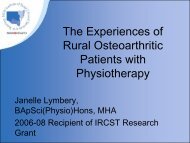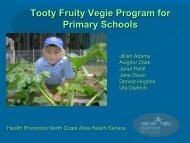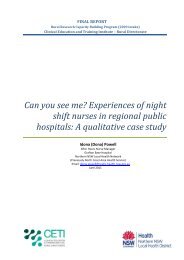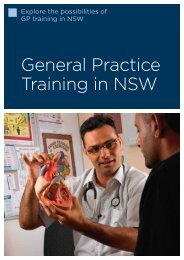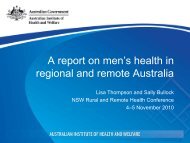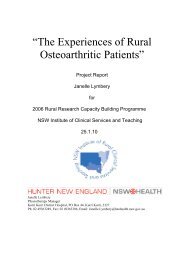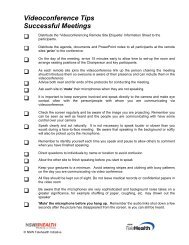Mister Germ Hygiene and Nutrition Program
Mister Germ Hygiene and Nutrition Program
Mister Germ Hygiene and Nutrition Program
- No tags were found...
Create successful ePaper yourself
Turn your PDF publications into a flip-book with our unique Google optimized e-Paper software.
AimProvide resources <strong>and</strong> train teachers to implementa sustainable nutrition <strong>and</strong> hygiene program intheir whole early childcare centre & community tolower the risk of disease transmission.
Nature <strong>and</strong> extent of the problemOutbreaks of communicable disease in children agedbetween 0 –5 yrs. E.g. cryptosporidium, boils &whooping cough.Fear of outbreaks like H1N1 have highlighted theimportance of good hygiene practices, nutrition & foodsafety requirements.Children in childcare are particularly vulnerable toinfectious disease.Many Childcare Centres are isolated with limitedaccess to health informationor support.
Strategic importanceThe program is based on best practice health promotionprincipals (Ottawa Charter, 1996).A multi‐strategic program, strengthening primary health <strong>and</strong>continuing care in the community.Builds regional partnerships in rural <strong>and</strong> remotecommunities.Re‐investment ‐ shifts resources to support prevention.
Planning & implementing solutionsLiterature review was undertaken to identify culturallyappropriate hygiene health promotion programs. Queensl<strong>and</strong><strong>Mister</strong> <strong>Germ</strong> Primary School Model identified.Partnerships formed between health services <strong>and</strong> early childcare centres to progress program design.2007 pilot program evidenced high incidence of child carechildren sick daily. Aboriginal preschools an average of 17% ofchildren reported sick daily compared to non‐Aboriginalpreschools 7%.
<strong>Hygiene</strong> <strong>Program</strong> ComponentA teacher's/presenter's activity guide containing fun flexibleinteractive activities.Includes props to perform activities i.e. <strong>Mister</strong> <strong>Germ</strong> <strong>and</strong><strong>Germ</strong>inator Costumes, UV light <strong>and</strong> magic cream.Communicable diseases information fact sheets <strong>and</strong>immunisation schedules.
Section 2. Implementation of a ProjectProposal10
<strong>Nutrition</strong> <strong>Program</strong> ComponentA nutrition kit <strong>and</strong> display –Great Lunch Box DilemmaDeadly Tucker nutritional program
-12
Food Safety <strong>Program</strong> Component“Junga‐Marlannggu Yuraal”‘Proper serving of food ’Toolkitfor Early Childcare Centres
<strong>Program</strong> ComponentsJunga‐marlanngguYuraal Kit – DalaigurPreschool
Outcomes & evaluationIncrease of post‐program rate of h<strong>and</strong> washing amongchildren.Increased knowledge of hygiene <strong>and</strong> nutrition.Early Childhood Centres have reviewed hygiene <strong>and</strong>nutrition policies.<strong>Program</strong> is friendly, flexible, culturally appropriate,quick <strong>and</strong> easy to implement.
Outcomes & evaluation<strong>Mister</strong> <strong>Germ</strong> established in 10 local government areas 2009NSW North Coast115 teachers trained78 early childcare centres attended training6,000 children across the NCAHS now have the opportunity toparticipate in this program.2010 –Currently being exp<strong>and</strong>edon the North Coast
Outcomes & evaluation<strong>Program</strong> is being utilised:Croc Festival, Kempsey: 2006 <strong>and</strong> 2007 – 10,000 kids.Shake a Leg <strong>Program</strong> –25 Primary Schools .Animal Management in Rural Remote Indigenous Communities(AMIRRIC) dog health program.Greenhill's Primary School boil outbreak 2008.
Lautoka School Fiji
Outcomes & evaluationNational H<strong>and</strong> Washing Day 5 May 2010 –<strong>Mister</strong> <strong>Germ</strong>appeared on Channel 7 Sunrise, as part of a segment organisedby the Clinical Excellence Commission.
Sustaining ChangeResource shared among Early Childcare CentresNCAHS maintain a school database, the kits, manage theloan roster <strong>and</strong> provide staff training <strong>and</strong> support.Assists Early Childcare Centres to meet Department ofCommunity Service accreditation requirements.100% of Early Childcare Centres trained in the programhave committed to this programCost neutral program.
ChallengesLimited workforce capacityThere was the assumption basic hygiene resourceswould be available to implement this program inschools.Primary Schools are not required to provide soap <strong>and</strong>h<strong>and</strong> drying facilities to students.
Future Scope 2010 <strong>and</strong> beyondContinue to be delivered <strong>and</strong> exp<strong>and</strong>ed on the North CoastNSW Health Aboriginal Environmental Health Branch hasformed a <strong>Mister</strong> <strong>Germ</strong> focus group to plan <strong>and</strong> implement thisprogram in NSW.Nationally enHealth ‐ Northern Territory established aworking group to develop an Indigenous <strong>Germ</strong> Theory Kit <strong>and</strong>provided funding for this project <strong>and</strong> resources.Queensl<strong>and</strong> is seeking to adopt the NCAHSmodel of the <strong>Mister</strong> <strong>Germ</strong> program in EarlyChildcare Centres across that state.
I wish to acknowledgeUncle Martin Ballangarry fromGumbaynggirr for the <strong>Germ</strong>inatorCharacter


